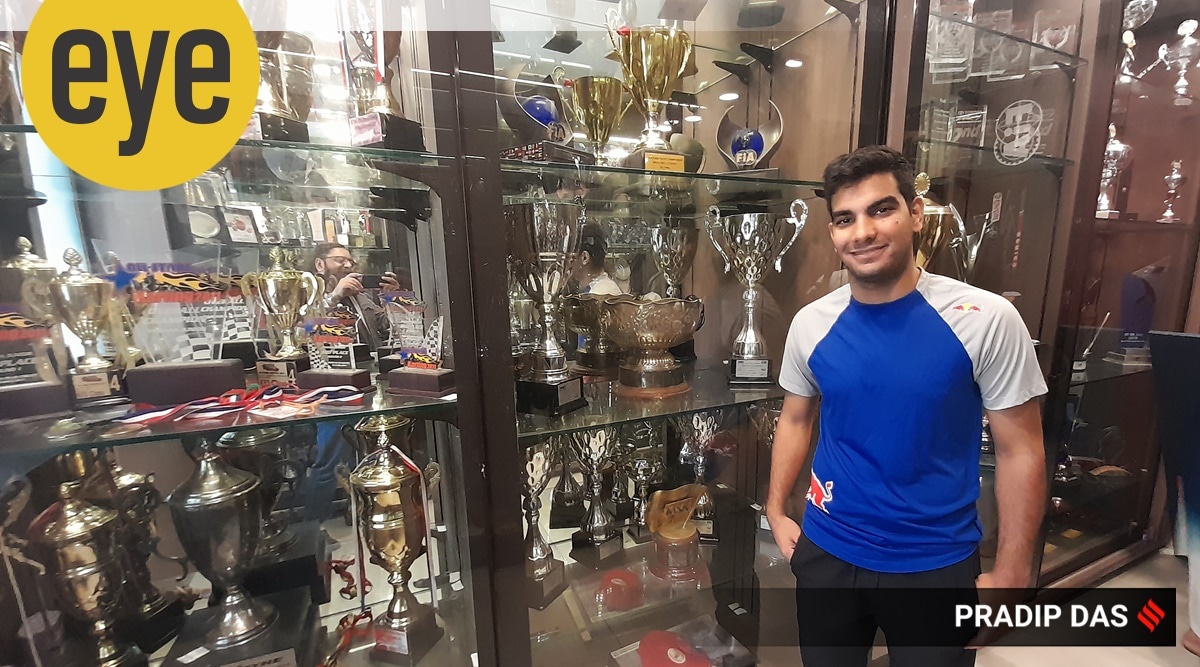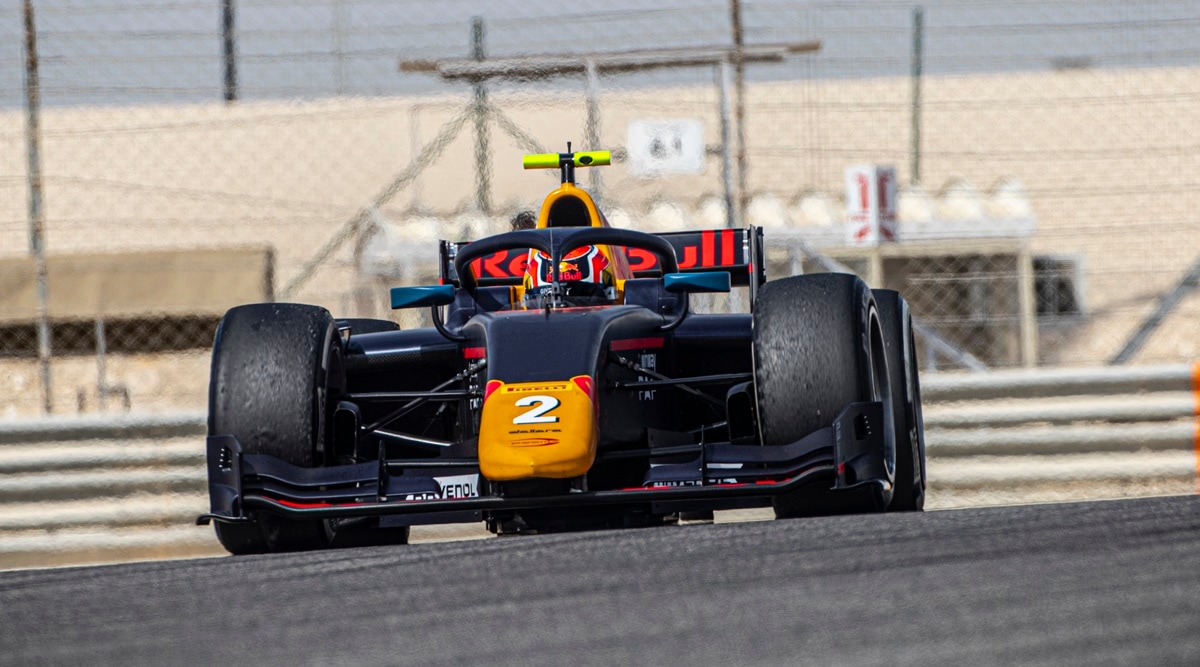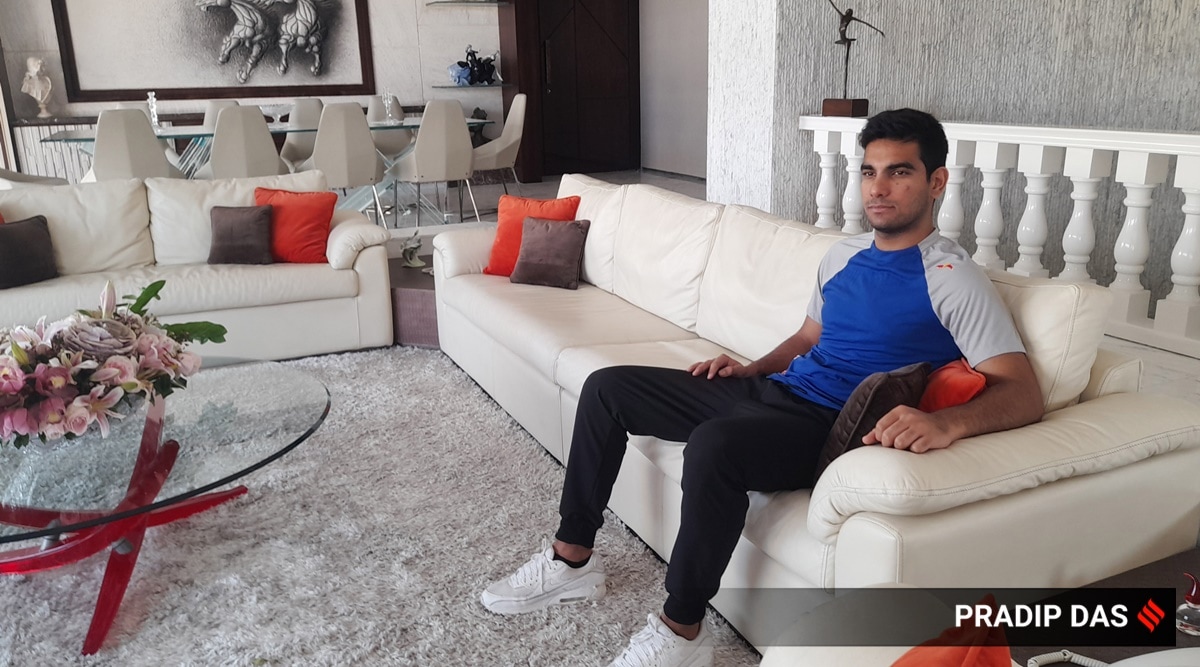 The seats for next year’s Formula One season are likely to be finalised by August-September (Express Photo By Pradip Das)
The seats for next year’s Formula One season are likely to be finalised by August-September (Express Photo By Pradip Das) “I have been a fan of speed, always,” says Jehan Daruvala, strolling in a bright and breezy living room of his fifth-floor apartment in the heart of Mumbai, overlooking a quiet, leafy lane that drowns out the noise of the gridlock at a junction not too far away.
Nothing about the picture-perfect Dadar Parsi Colony suggests it was built with speed in mind.
The roads are wide and covered in a canopy of trees; the rows of beautiful buildings – some old yet robust, some new and stylish – are well-spaced and surrounded by huge gardens. At a laidback café around the corner of the street, just off a chaotic roundabout, patrons sip the milky, sugary tea and flip through newspapers. Near its entrance, a rust-covered Ambassador with an old number plate completes the charm of this quaint locality, totally detached from the hustle of the rest of the city.
Nothing, really, about the place screams “fast”.
From here, a 23-year-old racer has emerged, aspiring to not just be the fastest Indian on wheels but also become the first from the country in a decade to make it to Formula One racing. “Not adding pressure on me,” Daruvala says, “but everything is in my hands.”
Daruvala appears relaxed, just like his surroundings. We meet on Valentine’s Day, his last day at home before flying off first to Europe and then to Bahrain, where he will compete in the season’s first Formula 2 race on Sunday.
Few sports are as cut-throat and unforgiving as F1. But Formula 2, a rung below and a stepping stone to the big league, is a different beast. “You are fighting for your own career, for yourself to go to F1,” Daruvala, who won two F2 races last season, says. “There is obviously respect for your teammate and your team, but yeah, you are definitely more out there for yourself in F2.”
Daruvala is an amiable young man and this is a rare glimpse into the mind of the soft-spoken admirer of cricketer Virat Kohli. But once he steps into his driving suit, he transforms into a tough nut, who isn’t shy to show his killer instinct. “You have to have that to win,” he says.
Especially when a lot is at stake, like the racing season in front of him.
***
At an Indian Express event a few months ago, historian Ram Guha said, “all good things in Bombay are named after Parsis.” Arguably, they are pioneers of sorts in sports as well. They were, after all, the first ones in India to pick up a bat and a ball, the first from the country to cycle around the world and have also produced a multiple-time national champion in swimming.
If he makes it, Daruvala won’t be the first Indian to race in Formula One. Narain Karthikeyan broke that glass ceiling in 2005 and Karun Chandhok followed his footsteps by breaking into F1 in 2010.
However, the mere challenge for an Indian racer to get an opportunity to fight for an F1 seat and the many hurdles that come along the way make Daruvala’s quest that much more intriguing. The last time an Indian raced in F1 was in 2012 when Karthikeyan made the grid for the Brazilian GP. This is the closest anyone from the country has come since then.
 I moved to cars (from racing go-karts) at 17-18 years old whereas everyone moves at 14-15 years (Credit: Prema Racing)
I moved to cars (from racing go-karts) at 17-18 years old whereas everyone moves at 14-15 years (Credit: Prema Racing) “Right now, there’s no pathway to go to F1 by just racing in India,” Daruvala says. “I moved to cars (from racing go-karts) at 17-18 years old whereas everyone moves at 14-15 years. So that’s definitely a factor. I started late, so I moved to cars late.”
Even his initiation to the sport was late by international standards. Daruvala says he watched F1 on TV when he was seven or eight years old; by that age, many drivers in countries with proper racing traditions are already driving karts. For Daruvala, even finding a place where he could do go-karting was a challenge.
The first time he went to a private club in Mumbai’s central suburbs, accompanying his father Khurshed and elder sister Delna as an eight-year-old, “Jeh” – as he is called at home – struggled to even fit into a kart. “He didn’t reach the pedals,” Delna laughs. “We had to put two-three cushions behind him so he could reach the pedals.”
Khurshed adds: “From the first day, Jehan loved it. He kept saying he wanted to pursue it but I wasn’t aware of a national championship or anything, till I saw an ad in a newspaper while on a flight back home from Delhi.”
The ad was by one of India’s most renowned racing coaches Rayomand Banajee about a three-day training camp in Mumbai, where he would teach the basics in karting. Daruvala, nine years old at the time, was the youngest at that camp, which turned out to be his first step into the world of motorsports. Within no time, he would spend the weekends racing in Kolhapur, home to one of India’s finest karting tracks, and soon start dominating the national scene.
In 2011, he was one of the three drivers (Tarun Reddy and Arjun Maini being the other two) to win a talent hunt organised by Force India, the first F1 team from the country. It opened the doors to the driving scene in the UK, considered to be one of the biggest motorsport nations.
“Jehan would fly out to the UK on Wednesdays, we took special permission from his school to let him go, race there over the weekends and fly back to Mumbai on Monday early morning,” his mother Kainaz says. “He would study at airports, on planes…”
Apart from more frequent races against quality opponents, the trips to the UK exposed Daruvala to finer nuances of the sport under his coach Tony Fullerton, a former world karting champion.
Fuller says he got the three Indian boys seats with the Ricky Flynn Motorsport but Daruvala, he adds, stood out. “All three boys were out of their depth at the start,” Fullerton says. “They got better as the year progressed but by the end of the year, it was obvious Jehan was the better of the three drivers, more complete.”
Daruvala, he says, was calm-headed and showed a willingness to learn. He taught him the techniques of racing in different weather conditions — in India, for instance, the hot weather conditions mean the tyres would already be warm by the time the karts would leave the garage and hit the track. In the UK, he had to race in severe cold conditions, as well as rain and hail — the power of visualisation before a race and the art of identifying racing lines.
By now, Daruvala had moved his base to England, knowing trips every weekend were not sustainable.
In India, for instance, the hot weather conditions mean the tyres would already be warm by the time the karts would leave the garage and hit the track. In the UK, he had to race in severe cold conditions, as well as rain and hail. Daruvala was taught the tricks to adapt to different racing conditions and the art of identifying racing lines but he also knew flying to the UK every weekend wasn’t sustainable.
So, he decided to move his base to England. “A lot of people have to make that sacrifice to go abroad, to UK or Italy. You go there, especially early on in your karting career, and spend most of your life there.”
***
The move was so audacious that few could believe it. In the Formula 2 sprint race in Jeddah last season, Daruvala was locked in a middle-of-the-grid scramble with nothing special to show. Until the final corner of lap 16, when he held on to the inside line in a tight space and as the two cars in front of him – Oscar Piastri, now a reserve driver in F1, and Christian Lundgaard – went a little wide, Daruvala passed them both at the same time and pulled away in a blink of an eye.
“To overtake one car is difficult in racing, to be able to take two cars, and not any two cars – Piastri and Lundgaard, both world-class – that was definitely one of my best moves,” Daruvala says.
The commentator spontaneously called it one of the moves of the season, and it explains the buzz around the young Indian, who transitioned smoothly from karting to car racing, although consistency remains an issue.
 F1 Racer Jehan Daruwala at his Mumbai recedence. (Express Photo By Pradip Das)
F1 Racer Jehan Daruwala at his Mumbai recedence. (Express Photo By Pradip Das) Last week, there were murmurs in the paddocks, as reported by the BBC, that Daruvala was on the shortlist of the Haas F1 Team, who had sacked their Russian driver Nikita Mazepin following the country’s invasion of Ukraine. Nothing concrete has come out of it yet but Daruvala is aware he won’t get many more chances.
He stopped short of calling it a make-or-break season, but it has come down to that. Formula One teams aren’t known for their patience, and it is widely held if a driver is unable to secure a seat after three seasons in Formula 2, chances for the future diminish.
Daruvala says everything is set up nicely for him to stake a claim for F1. As a member of the junior team of Red Bull, he has the backing of a racing powerhouse. This season, he has joined one of the most successful teams in F2, Prema. The Italian outfit has produced three of the last five F2 champions, including Charles Leclerc, Michael Schumacher’s son Mick and 2021 winner Oscar Piastri; all of whom have graduated to the top tier.
The seats for next year’s Formula One season are likely to be finalised by August-September. For Daruvala, that means it is crucial to start the season with a bang. “I want to win the championship, that’s the main target. I won’t think about that 24×7. Right now, my focus is round 1 and round 2. Tick those two boxes off and hopefully, I’ll have a good start. I have a year to perform, a year to deliver results,” he says.
And a year to take the crucial final step.
| The Road to Formula One Having started as a go-kart racer, Jehan Daruvala is within touching distance of a Formula One seat. Here’s how his career progressed: Karting: It’s the first step in racing. Coached by Rayomand Banajee, Daruvala began karting when he was nine. In 2013, he moved to the UK for more opportunities and was away karting for roughly 125 days a year. Formula 4: When Daruvala began, this stage was called Formula Renault. It is the entry-level series for motor racing where drivers learn advancing techniques before progressing to higher classes. Formula 3: It’s one of the main steps for many prospective F1 drivers. Daruvala competed at this level in 2019 and won two races along with seven podium finishes. India’s Kush Maini will be a part of this event in 2022. Formula 2: Seen as a stepping stone to F1, Formula 2 was started in 2017. Its races are held during the same weekend as F1 races and in a way, it’s a scouting ground for F1 teams. Daruvala is the only Indian in F2 this season. |
| Indians in Formula One |
| Narain Karthikeyan: Became the first Indian to compete in F1, when he was signed by Jordan in 2005. He is also the last Indian to race in the big league, after he turned out for HRT in the 2012 season. |
| Karun Chandhok: In 2010, he drove for Hispania Racing in 10 races and the following year, he had one appearance with Lotus. Later, he competed in other motorsports events, including Formula E and 24 Hours Le Mans. |
- The Indian Express website has been rated GREEN for its credibility and trustworthiness by Newsguard, a global service that rates news sources for their journalistic standards.

